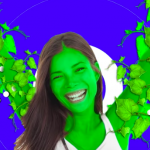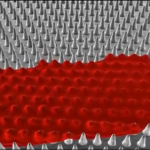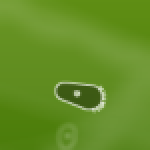cell biology
The latest in GMO technology: Photosynthesizing Human Beans!
This is silly, but makes some good points. May be good for teachers in your biology class:
Sean B. Carroll is coming out with a new book called The Serengeti Rules: The Quest to Discover How Life Works and Why It Matters.
This is the molecular biologist Sean Carroll, as distinct from the physicist (who wrote this).
Homeostasis is one of the basic principles of biology. The term can be applied broadly to mean that certain numbers are maintained within a certain range. This could refer to energy flowing through a system, numbers of specific cellular products like enzymes, numbers of individual organisms in an ecological system, etc. It is not so much that numbers don't change.…
The "clanger cicada" can physically kill bacteria by poking and shredding them with tiny pointy structures that seem to look a little like an old fashioned cheese grater. Keep in mind that this happens at a very small spacial scale, so the relationship between objects is different than in normal human experience. Essentially, the membrane of a bacterium spreads itself over the pointy nano-spikes of the insect wing. This is a little like a failed "laying on the bed of nails" attempt, but where the force involved with the bed of nails is gravity, gravity has nothing to do with the bacterium…
Here is a press release from BioMed Central that is just so interesting I had to give it to you as it is without delay:
Connecting cilia: cellular antennae help cells stick together
Primary cilia are hair-like structures which protrude from almost all mammalian cells. They are thought to be sensory and involved in sampling the cell's environment. New research, published in BioMed Central's open access journal Cilia, launched today, shows that cilia on cells in the retina and liver are able to make stable connections with each other - indicating that cilia not only are able to sense their…
Craig Venter and team make a historic announcement: they've created the first fully functioning, reproducing cell controlled by synthetic DNA. He explains how they did it and why the achievement marks the beginning of a new era for science.
Scientists are reporting that they have made a living cell from DNA that was originally synthesized in a lab. This isn't quite a synthetic organism. But the result is an important, and some would say troubling step on the road to creating life in the lab.
Craig Venter is the scientist behind the effort. Many scientists have strong opinions about Venter, but even his detractors will admit he's a man who thinks big.
details here
tags: Glowing Life in an Underwater World, marine biology, bioluminescence, luciferase, luciferin, green fluorescent protein, eye-in-the-sea cam, ethology, evolution, Edith Widder, TEDTalks, streaming video
Some 80 to 90 percent of undersea creatures make light -- and we know very little about how or why. Bioluminescence expert Edith Widder explores this glowing, sparkling, luminous world, sharing glorious images and insight into the unseen depths (and brights) of the ocean.
TEDTalks is a daily video podcast of the best talks and performances from the TED Conference, where the world's…
tags: The Nature of Cell Science, cell biology, microscopy, research, science, music, Venetian Snares, Szamár Madár, field work, Dirk Pacholsky, streaming video
Cell biologist, Dirk Pacholsky, created this video. He writes; "Certainly it´s irony in the title, because these images never made it to publication status. Sitting over the microscope, whilst listening to music the idea popped up to combine microscopic imagery with electronic music. The Scientist will certainly see more than a carpenter, but both might enjoy the beauty. Concerning the accompanying music, it is Venetian Snares (oh…
It turns out I write academia erotica!
I can tell you that the three dimensional visual imagery in the post to which Stephanie refers was a replacement for the actual visual imagery I had in mind when I wrote it. But I couldn't use that because ...
... because it was too narrowly defined, topically, focusing on protein function in the intracellular environment. But I can tell you how that image would look.
In the ultra tiny world of proteins, inside cells, there is little difference between form and function. Form is function. Its like putting a hammer and a pile of nails in your…
Alright. I understand the prohibition on not taking photos of presenters' data.
However, prohibiting Twittering?
Use of cameras and all other recording devices (this includes digital, film, and cell phone cameras, as well as audio recordings) are strictly prohibited in all session rooms, in the Exhibit Hall, and in all poster and oral presentation sessions. Twittering (see above) and other forms of communication involving replication of data are strictly prohibited at the Annual Meeting or before publication, whether data presented are in the Exhibit Hall, poster area, poster sessions, or…
tags: Lab Trash, recycle, molecular biology, cell biology, streaming video
I've been telling you about the perils of plastics, but some of the worst plastics offenders are molecular and cell biologists. Nearly every experiment that we do uses incredible amounts of plastics. In cell biology or molecular biology labs the emphasis is on working sterile, quickly and reproducibly. So companies have been selling all these incredibly useful products to life science labs: sterile plastic tubes of all shapes and sizes, single wrap multi-well tissue culture plates, sterile plastic dishes, sterile…
Not content with sapping our productivity with the Space Game, Armor Games have released another little science-themed gem in Microbe Kombat. The premise is simple - guide your microbe through the primordial ooze, eat proteins, and engulf smaller microbes. There are two broad strategies: keep eating protein until you're the biggest bully on the block, or keep dividing until you swarm out the enemy. Both have their pros and cons - dividing will make you and your daughter cells more vulnerable to macrophages, but many small microbes will out-compete a single large one in scavenging proteins…
Diatoms are algae with hard parts. They make up a major part of the plankton found in fresh and salt water environments. Usually, diatoms exist as single celled free floating organisms, but they can also be colonies of several single cells. Their tiny little 'shells' are made up of silica (these shells are called "fustules").
The fustules have a characteristic shape that goes with each species, and since these are hard (essentially, made of glass) they are often well preserved in sediments. Thus, diatoms actually provide an excellent, even if very tiny, fossil record. In addition, since…
But it might be worth thumbing through it just for fun ...
You must be over 18 to read the rest of tis blog post.
------------------------- the fold -----------------------------
Natural Harvest - A Collection of Semen-Based Recipes
Semen is not only nutritious, but it also has a wonderful texture and amazing cooking properties. Like fine wine and cheeses, the taste of semen is complex and dynamic. Semen is inexpensive to produce and is commonly available in many, if not most, homes and restaurants.
But employees must wash their hands before returning to work ...
Despite all of these…
The original video couldn't make it, so here's a substitute teacher video:
Allen's Rule. One of those things you learn in graduate school along with Bergmann's Rule and Cope's Rule. It is all about body size. Cope's Rule ... which is a rule of thumb and not an absolute ... says that over time the species in a given lineage tend to be larger and larger. Bergmann's Rule says that mammals get larger in colder environments. Allen's Rule has mammals getting rounder in colder climates, by decreasing length of appendages such as limbs, tails and ears.
All three rules seem to be exemplified in human evolution. Modern humans tend to be larger and rounder in cooler…
Sue Lynn Lau chose classical ballet and highly kinetic party dancing as the way to interpret her Ph.D. thesis, "The role of vitamin D in beta-cell function." As The Nutcracker Suite lilts in the background, Lau, a graduate student from the Garvan Institute of Medical Research in Sydney, Australia, appears as the Sugarplum Fairy, delivering marshmallow glucose to four beta cell dancers. Meanwhile, a fifth dancer flings and twirls around the stage--representing the sunlight required for vitamin D biosynthesis.
aaas Science
A protist is a single celled eukaryotic organism, and they are usually pretty small. You can often see them, though! Before you put that sample of pond water under the microscope, take a close look: Many protists are at the boundary of visibility for humans.
Then, there are the giant protists, grape size, living on the bottom of the sea where they roll around in the mud. It has been known for some time that there are giant deep sea protazoans that are not mobile. Here, though, is a bit of film of giant mobile protists.
A recent paper in Current Biology links these creatures to very…
The paper I'm about to discuss is a minefield of potential misconceptions that arise from the way we often use language do describe natural phenomena. This is a situation where it would be easier to start with a disclaimer ... a big giant obvious quotation mark ... and then use the usual misleading, often anthropomorphic language. But I don't think I should do that. We'll address this research the hard way, but the result will be worth the extra work.
Here is the basic hypothesis. The null model is that genetic variation arises randomly and this variation is the raw material on which…



